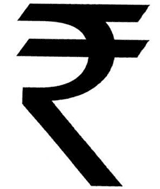 India’s rupee is now in an exclusive club – it joins Japan, Britain, the European Union and the U.S. as the only currencies to have globally recognized symbols.
India’s rupee is now in an exclusive club – it joins Japan, Britain, the European Union and the U.S. as the only currencies to have globally recognized symbols.
The new symbol, shown above, came out of a contest held by the Indian government that attracted more than 3,000 entries. A student at the Indian Institute of Technology was the winner.
Along with its role in global commerce, the new symbol will standardize currency communication across India, where 15 languages are commonly spoken. The government also hopes the symbol will set it apart from other countries with currencies of the same name, among them Pakistan, Nepal, Indonesia and Sri Lanka.
The rupee symbol combines ancient Hindi script with the letter R. The parallel horizontal lines at the top are a reference to the Indian flag and to the nation’s efforts to promote equality among its people.
India’s $1.2 trillion economy is the 10th largest in the world. That wealth, however, is not spread evenly among its people. The country ranks 139th in per-capita income, and some 450 million people – 40 percent of the population – live below the poverty line.
As bad as this number is, it used to be much worse: 90 percent of Indians were below the poverty line in 1980.
But if India is to meet the high expectations many have for it, it has to aim much higher than just the poverty line. The government must have effective policies to build much-needed infrastructure and stimulate the growth of India’s middle class.
This is the strategy that worked for China, and we think it could work for India as well.
- Bulenox: Get 45% to 91% OFF ... Use Discount Code: UNO
- Risk Our Money Not Yours | Get 50% to 90% OFF ... Use Discount Code: MMBVBKSM
Disclaimer: This page contains affiliate links. If you choose to make a purchase after clicking a link, we may receive a commission at no additional cost to you. Thank you for your support!


Indian Rupee Symbol Competition Hit By Injustice
According to RTI Documents : http://www.saveindianrupeesymbol.org
1. Non-eligible candidate was shortlisted in top five finalists. As candidate had submitted four designs.
2. One finalist was in contact with Finance Ministry and RBI prior to competition.
3. Design concept or brief was not put in front of jury along with Indian Rupee symbol design.
4. No marks or grades were allotted to selected (2644) candidates design entries, in the process of shortlisting top five finalist design entries.
5. Jury had spends less than 20 seconds on each design entries to analyze it .
6. Three jury member were absent in two days long meeting dated 29th Sept. and 30th Sept. 2009.
7. One jury member from Ministry of Culture was absent on the day of final presentation.
8. All seven jury member had never meet in this whole selection process in any given time.
9. No records are available with Finance Ministry which could indicated, how many total design entries Finance Ministry had received ?
10. Advertisement was only published in English language.(Only 23% on Indian population understand English)